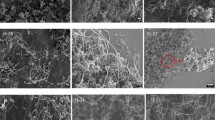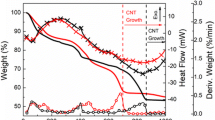Abstract
The formation and morphological control of catalyst nanoparticles (CNPs) are crucial for reliable carbon nanotube (CNT) growth. Effects of catalyst reduction and annealing on CNP formation and coarsening are key parameters that need to be elucidated. Here, we decoupled catalyst reduction and high temperature annealing of catalysts in order to investigate their roles and respective effects on CNP formation, evolution and morphology which are critical for controlling diameter-, density- and length-dependent morphologies of CNTs. We found that catalyst reduction at low temperature was not sufficient to form CNPs and it needed to be followed by exposure of Fe catalyst to high temperature for annealing. High temperature without the catalyst reduction did not help forming CNPs. When the catalyst reduction and high temperature annealing were coupled, it induced CNP coarsening via Ostwald ripening causing bimodal and sparse CNP formation. A recipe, consisting of low temperature catalyst reduction and subsequent exposure to high temperature for annealing in an inert gas environment, mitigated Ostwald ripening and was favorable to form uniform and dense CNPs. Diameters and densities of resulting CNTs showed proportionality to CNP morphologies. In addition, height of vertically aligned CNT (VACNT) forests linearly decreased with increasing catalyst reduction temperature.
Graphic abstract








Similar content being viewed by others
References
O.T. Gül, K.M. Pugliese, Y. Choi, P.C. Sims, D. Pan, A.J. Rajapakse, G.A. Weiss, P.G. Collins, Single molecule bioelectronics and their application to amplification-free measurement of DNA lengths. Biosensors (2016). https://doi.org/10.3390/bios6030029
M.V. Akhterov, Y. Choi, T.J. Olsen, P.C. Sims, M. Iftikhar, O.T. Gul, B.L. Corso, G.A. Weiss, P.G. Collins, Observing lysozymes closing and opening motions by high-resolution single-molecule enzymology. ACS Chem. Biol. 10, 1495–1501 (2015). https://doi.org/10.1021/cb500750v
Q.Y. Meng, S. Wei, Z. Xu, Q. Cao, Y. Xiao, N. Liu, H. Liu, G. Han, J. Zhang, J. Yan, A.P. Palov, L. Wu, Hafnium oxide layer-enhanced single-walled carbon nanotube field-effect transistor-based sensing platform. Anal. Chim. Acta. 1147, 99–107 (2021). https://doi.org/10.1016/j.aca.2020.12.040
D. Pan, E.J. Fuller, O.T. Gül, P.G. Collins, One-dimensional poole-frenkel conduction in the single defect limit. Nano Lett. 15, 5248–5253 (2015). https://doi.org/10.1021/acs.nanolett.5b01506
A. Chortos, G.I. Koleilat, R. Pfattner, D. Kong, P. Lin, R. Nur, T. Lei, H. Wang, N. Liu, Y.C. Lai, M.G. Kim, J.W. Chung, S. Lee, Z. Bao, Mechanically durable and highly stretchable transistors employing carbon nanotube semiconductor and electrodes. Adv. Mater. 28, 4441–4448 (2016). https://doi.org/10.1002/adma.201501828
M. Li, H.G. Park, Improved high-rate performance of a supercapacitor electrode from manganese-oxide-coated vertically aligned carbon nanotubes prepared by a pulsed current electrodeposition method. Electrochim. Acta. 296, 676–682 (2019). https://doi.org/10.1016/j.electacta.2018.11.062
H. Fu, Z.J. Du, W. Zou, H.Q. Li, C. Zhang, Simple fabrication of strongly coupled cobalt ferrite/carbon nanotube composite based on deoxygenation for improving lithium storage. Carbon N. Y. 65, 112–123 (2013). https://doi.org/10.1016/j.carbon.2013.08.006
X. Cui, S. Xu, X. Wang, C. Chen, The nano-bio interaction and biomedical applications of carbon nanomaterials. Carbon N. Y. 138, 436–450 (2018). https://doi.org/10.1016/j.carbon.2018.07.069
A. Antonucci, J. Kupis-Rozmysłowicz, A.A. Boghossian, Noncovalent protein and peptide functionalization of single-walled carbon nanotubes for biodelivery and optical sensing applications. ACS Appl. Mater. Interfaces. 9, 11321–11331 (2017). https://doi.org/10.1021/acsami.7b00810
O. Akhavan, M. Abdolahad, Y. Abdi, S. Mohajerzadeh, Silver nanoparticles within vertically aligned multi-wall carbon nanotubes with open tips for antibacterial purposes. J. Mater. Chem. 21, 387–393 (2010). https://doi.org/10.1039/C0JM02395G
S. Chakrabarti, H. Kume, L. Pan, T. Nagasaka, Y. Nakayama, Number of walls controlled synthesis of millimeter-long vertically aligned brushlike carbon nanotubes. J. Phys. Chem. C. 111, 1929–1934 (2007). https://doi.org/10.1021/jp0666986
B. Zhao, D.N. Futaba, S. Yasuda, M. Akoshima, T. Yamada, K. Hata, Exploring advantages of diverse carbon nanotube forests with tailored structures synthesized by supergrowth from engineered catalysts. ACS Nano 3, 108–114 (2009). https://doi.org/10.1021/nn800648a
C. Mattevi, C.T. Wirth, S. Hofmann, R. Blume, M. Cantoro, C. Ducati, C. Cepek, A. Knop-Gericke, S. Milne, C. Castellarin-Cudia, S. Dolafi, A. Goldoni, R. Schloegl, J. Robertson, In-situ X-ray photoelectron spectroscopy study of catalyst-support interactions and growth of carbon nanotube forests. J. Phys. Chem. C. 112, 12207–12213 (2008). https://doi.org/10.1021/jp802474g
S. Sakurai, M. Inaguma, D.N. Futaba, M. Yumura, K. Hata, Diameter and density control of single-walled carbon nanotube forests by modulating ostwald ripening through decoupling the catalyst formation and growth processes. Small 9, 3584–3592 (2013). https://doi.org/10.1002/smll.201300223
M. Schweiger, M. Schaudig, F. Gannott, M.S. Killian, E. Bitzek, P. Schmuki, J. Zaumseil, Controlling the diameter of aligned single-walled carbon nanotubes on quartz via catalyst reduction time. Carbon N. Y. 95, 452–459 (2015). https://doi.org/10.1016/j.carbon.2015.08.058
R. Pezone, S. Vollebregt, P.M. Sarro, S. Unnikrishnan, The influence of H2 and NH3 on catalyst nanoparticle formation and carbon nanotube growth. Carbon N. Y. 170, 384–393 (2020). https://doi.org/10.1016/j.carbon.2020.07.045
J.H. Kim, K.H. Lee, D. Burk, L.J. Overzet, G.S. Lee, The effects of pre-annealing in either H2 or He on the formation of Fe nanoparticles for growing spin-capable carbon nanotube forests. Carbon N. Y. 48, 4301–4308 (2010). https://doi.org/10.1016/j.carbon.2010.07.042
D.W. Jung, K.H. Lee, J.H. Kim, D. Burk, L.J. Overzet, G.S. Lee, S.H. Kong, Optimizing control of Fe catalysts for carbon nanotube growth. J. Nanosci. Nanotechnol. 12, 5663–5668 (2012). https://doi.org/10.1166/jnn.2012.6349
Seung Min Kim, L.P. Cary, B.A. Placidus, N.Z. Dmitri, H.H. Robert, B. Maruyama, E.A. Stach, Evolution in catalyst morphology leads to carbon nanotube growth termination. J Chem. Lett Phys (2010). https://doi.org/10.1021/jz9004762
E.R. Meshot, L. Plata, S. Tawfick, Y. Zhang, E.A. Verploegen, A.J. Hart, Nanotube Growth by Decoupled Catalyst 3, 2477–2486 (2009)
P.W. Voorhees, The theory of Ostwald ripening. J. Stat. Phys. 38, 231–252 (1985). https://doi.org/10.1007/BF01017860
A. Börjesson, K. Bolton, First principles studies of the effect of Ostwald ripening on carbon nanotube chirality distributions. ACS Nano 5, 771–779 (2011). https://doi.org/10.1021/nn101214v
T. De Los Arcos, M.G. Garnier, J.W. Seo, P. Oelhafen, V. Thommen, D. Mathys, The influence of catalyst chemical state and morphology on carbon nanotube growth. J. Phys. Chem. B. 108, 7728–7734 (2004). https://doi.org/10.1021/jp049495v
H. Sugime, S. Noda, S. Maruyama, Y. Yamaguchi, Multiple “optimum” conditions for Co-Mo catalyzed growth of vertically aligned single-walled carbon nanotube forests. Carbon N. Y. 47, 234–241 (2009). https://doi.org/10.1016/j.carbon.2008.10.001
B. Ingham, T.H. Lim, C.J. Dotzler, A. Henning, M.F. Toney, R.D. Tilley, How nanoparticles coalesce: an in situ study of Au nanoparticle aggregation and grain growth. Chem. Mater. 23, 3312–3317 (2011). https://doi.org/10.1021/cm200354d
M.L. Colaianni, P.J. Chen, J.T. Yates, Spectroscopic studies of the thermal modification of the Fe/Al2O3 interface. Surf. Sci. 238, 13–24 (1990). https://doi.org/10.1016/0039-6028(90)90061-C
P.A. Thiel, M. Shen, D.J. Liu, J.W. Evans, Coarsening of two-dimensional nanoclusters on metal surfaces. J. Phys. Chem. C. 113, 5047–5067 (2009). https://doi.org/10.1021/jp8063849
M.S. Dresselhaus, G. Dresselhaus, R. Saito, A. Jorio, Raman spectroscopy of carbon nanotubes. Phys. Rep. 409, 47–99 (2005). https://doi.org/10.1016/j.physrep.2004.10.006
O. Akhavan, E. Ghaderi, H. Emamy, Nontoxic concentrations of PEGylated graphene nanoribbons for selective cancer cell imaging and photothermal therapy. J. Mater. Chem. 22, 20626–20633 (2012). https://doi.org/10.1039/C2JM34330D
C.L. Cheung, A. Kurtz, H. Park, C.M. Lieber, Diameter-controlled synthesis of carbon nanotubes. J. Phys. Chem. B. 106, 2429–2433 (2002). https://doi.org/10.1021/jp0142278
M. Bedewy, E.R. Meshot, H. Guo, E.A. Verploegen, W. Lu, A.J. Hart, Collective mechanism for the evolution and self-termination of vertically aligned carbon nanotube growth. J. Phys. Chem. C. 113, 20576–20582 (2009). https://doi.org/10.1021/jp904152v
E.R. Meshot, A.J. Hart, Abrupt self-termination of vertically aligned carbon nanotube growth. Appl. Phys. Lett. 92, 90–93 (2008). https://doi.org/10.1063/1.2889497
M. Bedewy, B. Farmer, A.J. John Hart, Synergetic chemical coupling controls the uniformity of carbon nanotube microstructure growth. ACS Nano. 8, 5799–5812 (2014). https://doi.org/10.1021/nn500698z
Acknowledgements
This study was funded by the Scientific and Technological Research Council of Turkey (TÜBİTAK) under Career Development Program (CAREER) (grant number 118M586).
Author information
Authors and Affiliations
Corresponding author
Ethics declarations
Conflict of interest
The authors declare that they have no conflict of interest.
Additional information
Publisher's Note
Springer Nature remains neutral with regard to jurisdictional claims in published maps and institutional affiliations.
Rights and permissions
About this article
Cite this article
Gul, O.T. Decoupling the catalyst reduction and annealing for suppressing Ostwald ripening in carbon nanotube growth. Appl. Phys. A 127, 762 (2021). https://doi.org/10.1007/s00339-021-04916-9
Received:
Accepted:
Published:
DOI: https://doi.org/10.1007/s00339-021-04916-9




